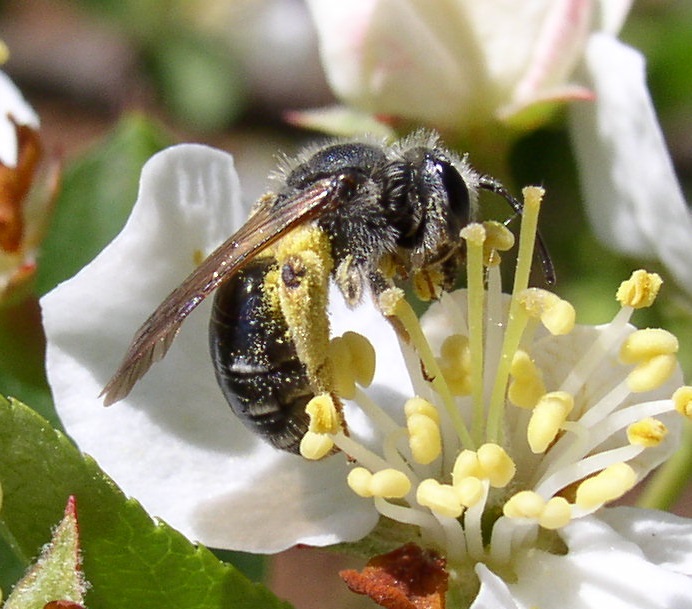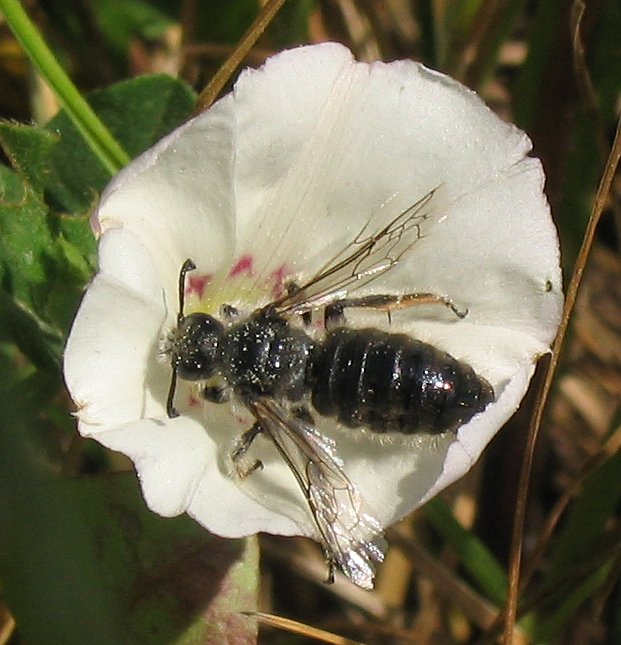|
Oligolectic
The term oligolecty is used in pollination ecology to refer to bees that exhibit a narrow, specialized preference for pollen sources, typically to a single family or genus of flowering plants. The preference may occasionally extend broadly to multiple genera within a single plant family, or be as narrow as a single plant species. When the choice is very narrow, the term ''monolecty'' is sometimes used, originally meaning a single plant species but recently broadened to include examples where the host plants are related members of a single genus. The opposite term is '' polylectic'' and refers to species that collect pollen from a wide range of species. The most familiar example of a polylectic species is the domestic honey bee. Oligolectic pollinators are often called oligoleges or simply specialist pollinators, and this behavior is especially common in the bee families Andrenidae and Halictidae, though there are thousands of species in hundreds of genera, in essentially all known ... [...More Info...] [...Related Items...] OR: [Wikipedia] [Google] [Baidu] |
Andrena Subgenus Gonandrena
''Andrena'' is a genus of bees in the family Andrenidae. With over 1,500 species, it is one of the largest genera of animals. It is a strongly monophyletic group that is difficult to split into more manageable divisions; currently, ''Andrena'' is organized into 104 subgenera. It is nearly worldwide in distribution, with the notable exceptions of Oceania and South America. Bees in this genus are commonly known as mining bees due to their ground-nesting lifestyle. Morphology ''Andrena'' are generally medium-sized bees; body length ranges between 8 and 17 mm with males being smaller and more slender than females. Most are black with white to tan hair, and their wings have either two or three submarginal cells. They carry pollen mainly on femoral scopal hairs, but many ''Andrena'' have an additional propodeal corbicula for carrying some pollen on their thorax. C. D. Michener (2007) ''The Bees of the World'', 2nd Edition, Johns Hopkins University Press. They can be disting ... [...More Info...] [...Related Items...] OR: [Wikipedia] [Google] [Baidu] |
Pollination
Pollination is the transfer of pollen from an anther of a plant to the stigma of a plant, later enabling fertilisation and the production of seeds, most often by an animal or by wind. Pollinating agents can be animals such as insects, birds, and bats; water; wind; and even plants themselves, when self-pollination occurs within a closed flower. Pollination often occurs within a species. When pollination occurs between species, it can produce hybrid offspring in nature and in plant breeding work. In angiosperms, after the pollen grain (gametophyte) has landed on the stigma, it germinates and develops a pollen tube which grows down the style until it reaches an ovary. Its two gametes travel down the tube to where the gametophyte(s) containing the female gametes are held within the carpel. After entering an ovum cell through the micropyle, one male nucleus fuses with the polar bodies to produce the endosperm tissues, while the other fuses with the ovule to produce the embr ... [...More Info...] [...Related Items...] OR: [Wikipedia] [Google] [Baidu] |
Pollen
Pollen is a powdery substance produced by seed plants. It consists of pollen grains (highly reduced microgametophytes), which produce male gametes (sperm cells). Pollen grains have a hard coat made of sporopollenin that protects the gametophytes during the process of their movement from the stamens to the pistil of flowering plants, or from the male cone to the female cone of gymnosperms. If pollen lands on a compatible pistil or female cone, it germinates, producing a pollen tube that transfers the sperm to the ovule containing the female gametophyte. Individual pollen grains are small enough to require magnification to see detail. The study of pollen is called palynology and is highly useful in paleoecology, paleontology, archaeology, and forensics. Pollen in plants is used for transferring haploid male genetic material from the anther of a single flower to the stigma of another in cross-pollination. In a case of self-pollination, this process takes place from the anth ... [...More Info...] [...Related Items...] OR: [Wikipedia] [Google] [Baidu] |
Genus
Genus ( plural genera ) is a taxonomic rank used in the biological classification of extant taxon, living and fossil organisms as well as Virus classification#ICTV classification, viruses. In the hierarchy of biological classification, genus comes above species and below family (taxonomy), family. In binomial nomenclature, the genus name forms the first part of the binomial species name for each species within the genus. :E.g. ''Panthera leo'' (lion) and ''Panthera onca'' (jaguar) are two species within the genus ''Panthera''. ''Panthera'' is a genus within the family Felidae. The composition of a genus is determined by taxonomy (biology), taxonomists. The standards for genus classification are not strictly codified, so different authorities often produce different classifications for genera. There are some general practices used, however, including the idea that a newly defined genus should fulfill these three criteria to be descriptively useful: # monophyly – all descendants ... [...More Info...] [...Related Items...] OR: [Wikipedia] [Google] [Baidu] |
Honey Bee
A honey bee (also spelled honeybee) is a eusocial flying insect within the genus ''Apis'' of the bee clade, all native to Afro-Eurasia. After bees spread naturally throughout Africa and Eurasia, humans became responsible for the current cosmopolitan distribution of honey bees, introducing multiple subspecies into South America (early 16th century), North America (early 17th century), and Australia (early 19th century). Honey bees are known for their construction of perennial colonial nests from wax, the large size of their colonies, and surplus production and storage of honey, distinguishing their hives as a prized foraging target of many animals, including honey badgers, bears and human hunter-gatherers. Only eight surviving species of honey bee are recognized, with a total of 43 subspecies, though historically 7 to 11 species are recognized. Honey bees represent only a small fraction of the roughly 20,000 known species of bees. The best known honey bee is the weste ... [...More Info...] [...Related Items...] OR: [Wikipedia] [Google] [Baidu] |
Andrenidae
The Andrenidae (commonly known as mining bees) are a large, nearly cosmopolitan family of solitary, ground-nesting bees. Most of the family's diversity is located in temperate or arid areas (warm temperate xeric). It includes some enormous genera (e.g., ''Andrena'' with over 1300 species, and '' Perdita'' with over 700). One of the subfamilies, Oxaeinae, is so different in appearance that they were typically accorded family status, but careful phylogenetic analysis reveals them to be an offshoot within the Andrenidae, very close to the Andreninae. C. D. Michener (2007) ''The Bees of the World'', 2nd Edition, Johns Hopkins University Press. Description The Andrenidae are typically small to moderate-sized bees, which often have scopae on the basal segments of the leg in addition to the tibia, and are commonly oligolectic (especially within the subfamily Panurginae). They can be separated from other bee families by the presence of two subantennal sutures on the face, a primitive ... [...More Info...] [...Related Items...] OR: [Wikipedia] [Google] [Baidu] |
Halictidae
Halictidae is the second-largest family of bees (clade Anthophila) with nearly 4,500 species. Halictid species are an extremely diverse group that can vary greatly in appearance. These bees occur all over the world and are found on every continent except Antarctica. Usually dark-colored (frequently brown or black) and often metallic, halictids are found in various sizes, colors and patterns. Several species are all or partly green and a few are red, purple, or blue. A number of them have yellow markings, especially the males, which commonly have yellow faces, a pattern widespread among the various families of bees. The family is one of many with short tongues and is best distinguished by the arcuate (strongly curved) basal vein found on the wing. Females in this family tend to be larger than the males. They are commonly referred to as "sweat bees" (especially the smaller species), as they are often attracted to perspiration. Ecology Most halictids nest in the ground, often in ha ... [...More Info...] [...Related Items...] OR: [Wikipedia] [Google] [Baidu] |
Larva
A larva (; plural larvae ) is a distinct juvenile form many animals undergo before metamorphosis into adults. Animals with indirect development such as insects, amphibians, or cnidarians typically have a larval phase of their life cycle. The larva's appearance is generally very different from the adult form (''e.g.'' caterpillars and butterflies) including different unique structures and organs that do not occur in the adult form. Their diet may also be considerably different. Larvae are frequently adapted to different environments than adults. For example, some larvae such as tadpoles live almost exclusively in aquatic environments, but can live outside water as adult frogs. By living in a distinct environment, larvae may be given shelter from predators and reduce competition for resources with the adult population. Animals in the larval stage will consume food to fuel their transition into the adult form. In some organisms like polychaetes and barnacles, adults are immobil ... [...More Info...] [...Related Items...] OR: [Wikipedia] [Google] [Baidu] |
Toxicoscordion
''Toxicoscordion'' is a genus of flowering plants in the family Melanthiaceae, tribe Melanthieae, first described as a genus in 1903. The genus is mainly distributed in the midwestern United States and western North America, with some species in western Canada and northern Mexico. Molecular phylogenetic studies in the 21st century have resulted in number of changes to placements within this tribe. ''Toxicoscordion'' was long submerged into the genus ''Zigadenus'', but its separate position in the phylogeny of the Melanthieae has been confirmed. Members of ''Toxicoscordion'' may also be distinguished from other similar members of the deathcamas tribe by the presence of narrow, clawed tepals with a single, conspicuous, rounded gland. ; Species * ''Toxicoscordion brevibracteatum'' (syn. ''Zigadenus brevibracteatus'') - desert deathcamas - Baja California, Sonora, California * ''Toxicoscordion exaltatum'' (syn. ''Zigadenus exaltatus'') - giant deathcamas - California, Nevada * ''To ... [...More Info...] [...Related Items...] OR: [Wikipedia] [Google] [Baidu] |
Melanthieae
Melanthieae is a tribe of flowering plants within the family Melanthiaceae. Molecular phylogenetic studies in the 21st century have resulted in a large-scale reassignment of many of its species to different genera; in particular the genus ''Zigadenus'' (deathcamases) has been restricted to a single species, ''Zigadenus glaberrimus''. Plants contain alkaloids, making them unpalatable to grazing animals; many are very poisonous to both animals and humans. Description Like the family as a whole, members of the tribe are "lilioid monocots", i.e. their flowers superficially resemble those of the genus ''Lilium'', with six tepals not differentiated into sepals and petals. As with other lilioid monocots, they were previously included in a broadly defined family Liliaceae. They are found mainly in woodland or alpine habitats in the temperate regions of the Northern Hemisphere (North America, Central America, and Asia), with one species found in South America. They are perennials, growing ... [...More Info...] [...Related Items...] OR: [Wikipedia] [Google] [Baidu] |
Passiflora Lutea
''Passiflora lutea'', commonly known as yellow passionflower, is a flowering perennial vine in the family Passifloraceae, native to the central and eastern United States. The vine has three-lobed leaves and small, yellowish-green, fringed flowers that appear in the summer, followed by green fruit that turn almost black at maturity. It grows in moist to wet habitats. Description ''P. lutea'' is a perennial, herbaceous, climbing or trailing, unbranched vine that can reach in length. Curled, springlike tendrils emerging from leaf axils help the vine to climb on structures or other vegetation. The leaves are trilobed, long and broad, with a petiole. Leaves have smooth (entire) margins and are alternate on the stem. The upper surface of the leaves is dark green, and may be mottled with splotches of lighter green. In the north of its range, it is deciduous. The showy flowers appear singly or in pairs on slender flower stalks up to long. Each flower is wide with narrow yellowish ... [...More Info...] [...Related Items...] OR: [Wikipedia] [Google] [Baidu] |






.jpg)
